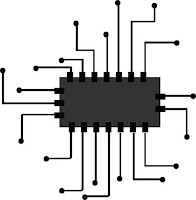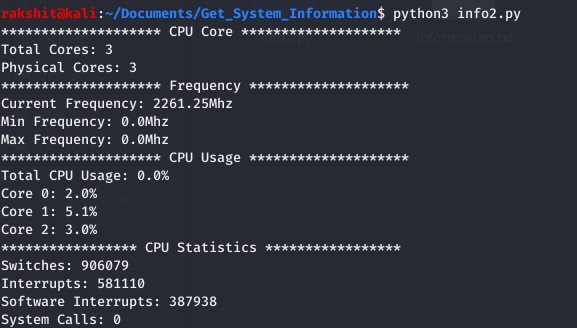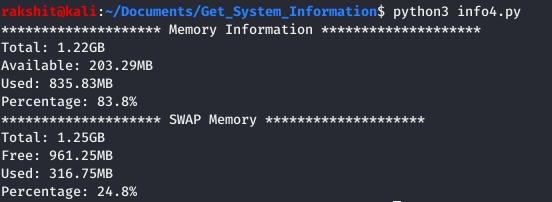
Introduction
In this tutorial, You will learn how to get hardware and system information using Python. Python offers two modules, platform, and psutil. Using these two modules we will find many information about our system. Both modules work on a cross-platform. So whatever operating system(Linux, Windows, or Mac) you are running, it will work perfectly for all of them👍.
You can find some basic information using the platform module but psutil offers many functions to get more information about a computer or system in detail. We will use both here.
Let’s look a glimpse at which details we’re going to find here through several Python programs.
🍁Learn Also: Extract Emails and Phone Numbers🔍 from a Text using Python Regex
The information we will find here
- Basic Hardware and System Information
- OS name,
- Node name,
- Version,
- Processor,
- Architecture, etc.
- Information about the users
- Current user,
- Total users of a system
- Boot Time
- CPU Information
- CPU count,
- CPU frequency,
- CPU usage of process,
- CPU statistics, etc.
- Memory Information
- RAM size,
- RAM usage,
- Free Space,
- SWAP memory details, etc.
- Disk information
- Total size,
- Free space,
- Total read & write since boot time, etc.
- Network Information
- Network usage
- Logical & Physical addresses, etc.
- Details about running process
- Total running processes,
- parent ids, child processes ids of a process, etc.
Get the Basic System Information
First, we will try with the platform module to get only the basic information of any computer.
Code
'''Get Hardware and System information using Python'''
import platform
my_pc = platform.uname()
print("n")
print(f"Operating System: {my_pc.system}")
print(f"Node Name: {my_pc.node}")
print(f"Release: {my_pc.release}")
print(f"Version: {my_pc.version}")
print(f"Machine: {my_pc.machine}")
print(f"Processor: {my_pc.processor}")
print(f"Architecture: {platform.architecture}")
print("n")
Output
User Information
Now find the user information of any system. The psutil.user() function returns a list, containing username, host-name, PID, etc.
Code
import psutil
print("*"*20, "User Details", "*"*20)
print(psutil.users())
Output
Boot Time
Boot Time: the time when the system was turned on. The psutil.boot_time() function returns the boot time in a compact form. We need to convert it into a human-readable format using the datetime.fromtimestamp() function.
Code
import psutil
from datetime import datetime
# Get the boot time
print("*"*20, "Boot Time", "*"*20)
bootTime = psutil.boot_time()
time = datetime.fromtimestamp(bootTime)
print(f"Your Boot Time is: {time.day}/{time.month}/{time.year}
{time.hour}:{time.minute}:{time.second}")
Output
CPU Information
Now get your CPU information through several functions of the psutil module.
The psutil.cpu_count() function returns the total number of CPU cores. psutil.cpu_freq() returns the current, minimum, and maximum frequency of the CPU and the value, it represents in megahertz(MHz).
psutil.cpu_stats(): for CPU statistics. For example, the number of software interrupts, switches, system calls, etc.
Code
import psutil
# CPU count
print("*"*20, "CPU Core", "*"*20)
print("Total Cores:", psutil.cpu_count())
print("Physical Cores:", psutil.cpu_count(False))
# CPU Frequency
print("*"*20, "Frequency", "*"*20)
frequency = psutil.cpu_freq()
print(f"Current Frequency: {frequency.current:.2f}MHz")
print(f"Min Frequency: {frequency.min}MHz")
print(f"Max Frequency: {frequency.max}MHz")
# CPU usage
print("*"*20, "CPU Usage", "*"*20)
print(f"Total CPU Usage: {psutil.cpu_percent()}%")
for x, prc in enumerate(psutil.cpu_percent
(interval=1,percpu=True)):
print(f"Core {x}: {prc}%")
print("*"*17, "CPU Statistics", "*"*17)
# CPU Statistics
stats = psutil.cpu_stats()
print(f"Switches: {stats.ctx_switches}")
print(f"Interrupts: {stats.interrupts}")
print(f"Software Interrupts: {stats.soft_interrupts}")
print(f"System Calls: {stats.syscalls}")
Output
Memory Information
Here we will write a program to get the information about the Main Memory. psutil.virtual_memory() returns the information about a RAM. For instance, RAM size, available space, used space and percentage, etc.
Here, I’ve used a function, size_converter() to make the space information in a more readable format. Like KB, MB, GB, etc. as needed. Because all the functions return details about spaces in the byte form and it’s not convenient for humans to grip the actual message.
Code
import psutil
def size_converter(size):
# 2**10 = 1024
i = 0
num = 2**10
units = {0 : '', 1: 'K', 2: 'M', 3: 'G', 4: 'T'}
while size > num:
size /= num
i += 1
return f"{size:.2f}{units[i]}{'B'}"
# Memory Information
print("*"*20, "Memory Information", "*"*20)
mem = psutil.virtual_memory()
print(f"Total: {size_converter(mem.total)}")
print(f"Available: {size_converter(mem.available)}")
print(f"Used: {size_converter(mem.used)}")
print(f"Percentage: {mem.percent}%")
# Information of the swap memory
print("*"*20, "SWAP Memory", "*"*20)
swap = psutil.swap_memory()
print(f"Total: {size_converter(swap.total)}")
print(f"Free: {size_converter(swap.free)}")
print(f"Used: {size_converter(swap.used)}")
print(f"Percentage: {swap.percent}%")
Output
Disk Information
This program will find the details of the external storage(HDD or SSD). For example, total space, available space, used space, total read and write, etc.
Code
"""Get Disk Information"""
import psutil
def size_converter(size):
# 2**10 = 1024
i = 0
num = 2**10
units = {0 : '', 1: 'K', 2: 'M', 3: 'G', 4: 'T'}
while size > num:
size /= num
i += 1
return f"{size:.2f}{units[i]}{'B'}"
print("*"*20, "Disk Information", "*"*20)
# Total Disk Usage
totalUsage = psutil.disk_usage('/')
print(f"Total Size: {size_converter(totalUsage.total)}")
print(f"Used: {size_converter(totalUsage.used)}")
print(f"Free: {size_converter(totalUsage.free)}")
print(f"Percentage: {totalUsage.percent}")
# Get I/O statistics
disk_io = psutil.disk_io_counters()
print(f"Total read: {size_converter(disk_io.read_bytes)}")
print(f"Total write: {size_converter(disk_io.write_bytes)}")
Output
Network Information
psutil.net_io_counters(): returns the information of network usage. For example, total data sent and received, etc.
psutil.net_if_addrs(): returns the details of logical, physical, broadcast addresses, netmask, etc.
Code
import psutil
def size_converter(size):
i = 0
num = 2**10
units = {0 : '', 1: 'K', 2: 'M', 3: 'G', 4: 'T'}
while size > num:
size /= num
i += 1
return f"{size:.2f}{units[i]}{'B'}"
# Network Usage
i_o = psutil.net_io_counters()
print(f"Total Data Sent: {size_converter(i_o.bytes_sent)}")
print(f"Total Data Received: {size_converter(i_o.bytes_recv)}")
print(f"Total Packets Sent: {i_o.packets_sent}")
print(f"Total Packets recived: {i_o.packets_recv}")
# Details of physical, logical network address,
# netmask, broadcast address, etc.
print("n")
print(psutil.net_if_addrs())
Output
Get the Details about Running Processes
The psutil module provides a function named pids() which returns a list, containing all the process ids that are currently running on the system.
psutil.Process() gives the information of a specific process. For example, parent ids, child processes ids, etc. You need to mention the PID as an argument to the function.
Code
"""Get the information about the
running processes"""
import psutil
process_id = psutil.pids()
counter = 0
for i in process_id:
counter += 1
print("Total Running Processes: ", counter)
# Get the information of a specific process
# 2646 is a process number.
process = psutil.Process(2646)
print(f"Process Name: {process.name()}")
print(f"Path: {process.exe()}")
print(f"Current directory: {process.cwd()}")
print(f"Command Line: {process.cmdline()}")
print("n", "*"*20, "Parent Informations", "*"*20)
print(f"Parent Id: {process.ppid()}")
print(f"Parent Details: {process.parent()}")
print(f"ALl Parents: {process.parents()}")
print("n", "*"*20, "Child Informations", "*"*20)
print(f"Child Processes: {process.children(recursive = True)}")
Output
Conclusion
In this tutorial, you learned how to get hardware and system information using Python programs. We used two Python modules here. One is platform module and another one is psutil. I’ve covered so many examples for getting several information about hardware and software both. I hope this tutorial will help you a lot. If you’ve any queries, let me know in the comment section below. I will reply to you soon.
Thanks for reading!💙

















